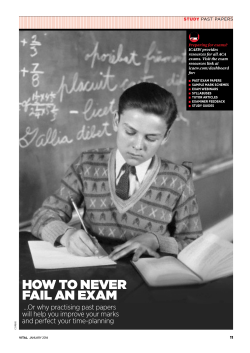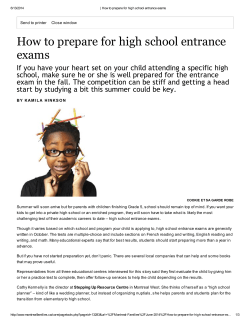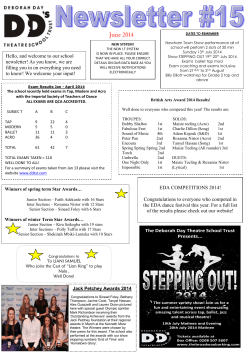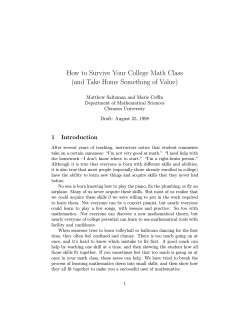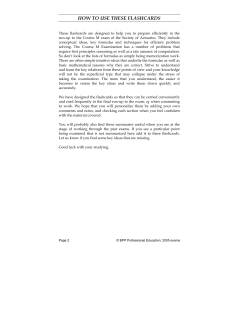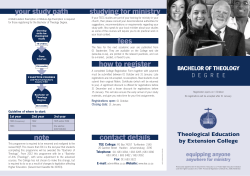
Learning from Others How to Teach Intermediate Accounting More
Learning from Others How to Teach Intermediate Accounting More Effectively: A Survey of Instructors on Course Content, Assessment and Course Management James F. Loebl University of Wisconsin-Green Bay The purpose of the study is to present a current picture of the context in which instructors operate and the methods used in teaching intermediate accounting courses. A survey of instructors at public four-year colleges and universities in 10 states found that instructors provide comprehensive coverage of their texts but very light coverage of International Financial Reporting Standards. Further, they rely heavily on traditional means such as exams to assign grades, rather than those emphasizing communications skills. The paper provides a baseline for future studies and an opportunity for instructors to consider incorporating different methods into their own courses. Over the past few years, as I have gone through the annual ritual of preparing syllabi for the two courses in intermediate accounting I teach in fall, I have wondered whether my courses properly prepare students for careers in the accounting profession and to take the Uniform Certified Public Accountant Examination (the CPA Exam) or a similar professional exam. I have also wondered whether my teaching methods are in synch with those of other intermediate accounting instructors. So, this past summer, I decided to survey colleagues about their approaches in three areas discussed below that have been of greatest concern to me: (1) the technical content to be covered in each course; (2) the means employed to assess students’ performance and assign grades; and (3) the administration of exams and management of the courses in a way that increases students’ satisfaction with their intermediate accounting courses. AREAS OF CONCERN IN TEACHING INTERMEDIATE ACCOUNTING Course Content One of the biggest challenges I face in teaching intermediate accounting is selecting the topics to be examined in each semester of a two-course sequence. The incongruity between the length of the textbook I have adopted (1,557 pages for the fifteenth and most recent edition of Intermediate Accounting by Kieso, Weygandt and Warfield) and the class time available to cover it (seven credit hours over two semesters in my case; many instructors only have six credit hours) requires difficult decisions as to which topics can be taught in sufficient detail for the students to understand and which have to be omitted. One of these choices is the extent to which I discuss and/or illustrate the proper accounting treatment under International Financial Reporting Standards (IFRS). The Securities and Exchange Commission (SEC) announced in July, 2012, that it was deferring action on requiring U.S. companies to incorporate IFRS into their reporting systems (U.S. Securities and Exchange Commission, Office of the Chief Accountant, 2012). Since then, there has been considerable uncertainty whether U.S. companies will have to transition 48 Journal of Higher Education Theory and Practice vol. 14(1) 2014 to IFRS and if so, the timeline for implementing the transition. One has to wonder whether scarce class time should be devoted to teaching standards that may never take effect or whose implementation may be delayed for years. Another dilemma is the coverage I should give to weighty topics, such as impairment of long-term receivables, troubled debt restructuring and derivatives, which the authors have placed in chapter appendices. Does such placement suggest that I should assign a much lower priority to covering these topics compared to any that are illustrated within the chapters? Assessment of Student Performance In assessing my students’ performance and assigning their grades, I place a very substantial weight on examinations. While I require one memorandum between one and five pages in length in each course, the memorandum accounts for slightly less than 10% of a student’s grade. In addition, on two or three occasions each semester, the students write up the answers they find to financial accounting questions they are asked to research in the Financial Accounting Standards Board’s (FASB) Accounting Standards Codification (ASC). The ASC assignments are submitted with other homework problems and are not graded for the quality of the students’ writing skills. Given the importance of strong communication skills in advancing their careers, I wonder if I should incorporate more written assignments to help the students develop those skills. With respect to examinations, I include problems for which the students can receive credit for each step or calculation performed correctly, as well as multiple choice, true/false and similar objective questions. The objective questions generally comprise 10-20% of the examinations. The students seem to prefer a format weighted heavily in favor of problems, and I believe that analyzing problems and presenting solutions in a clear, logical fashion will be far more critical to their success in the accounting profession than selecting the correct answer to a multiple choice question. However, I am concerned that the format may not adequately train the students to abstract concepts from the calculations and journal entries presented in class as multiple choice questions frequently require students to do. Further, I wonder if more multiple choice questions are warranted given their predominance on the CPA Exam. I would not question my exam structure if my students had the opportunity to take a CPA Exam review course for credit toward their degree and be schooled in the art of taking multiple choice tests. Course Management Issues Studying intermediate accounting can be both challenging and frustrating, so that I regularly evaluate changes I can make to increase the students’ satisfaction. The most frequent objections students raise about my classes are: (1) the text is difficult to read; (2) there should be more exams or opportunities to raise their grades; (3) students should be allowed to refer to their texts or notes during exams; and (3) common exams in the second course should be eliminated. I think the students’ main problem with the text is comprehending the technical language in which it is written. While I suspect this problem would occur with other texts, I am interested in finding out what texts other instructors use and open to a change that would facilitate the students’ grasp of the material. With respect to exams, I administer four, including the final, in my first course, a four-credit class, and three in the second course, a three-credit class. All tests are closed-book and no notes are permitted. Common exams are the norm in our program in the introductory and managerial accounting courses required of all business administration students. I prefer to administer them in my second intermediate course because they prevent unauthorized information passing between students in different sections and they permit scheduling an extended period for taking the exam (two hours versus an 80-minute regular class period). Unfortunately, due to classroom availability and the students’ class schedules, these exams are held on two Friday afternoons during the semester. Despite the sound reasons for common exams, they meet with resistance from the students. So, I have wondered whether other instructors administer common exams. If common exams are an uncommon practice among my colleagues, perhaps I should consider different testing options. Journal of Higher Education Theory and Practice vol. 14(1) 2014 49 Finally, there are many campus discussion groups and presentations on using clickers, flipping the classroom or other methods to engage students in a more interactive learning environment. As I have considered using clickers, I thought it would be interesting to learn if their use has caught on in intermediate accounting classrooms across the country. Having discussed the teaching issues and concerns I wanted to address in my survey, this paper will next provide a brief review of the literature on surveys of accounting instructors and their teaching methods. Following the literature review, the paper will then focus on: (1) the survey methodology; (2) the findings of the survey; and (3) changes to my methods that I have implemented or am considering as a result of the survey. Finally, the paper will conclude with a summary of the study and its findings. LITERATURE REVIEW With respect to the issues covered by the survey conducted in this study, two previous studies are relevant: (1) Dow and Feldmann’s (1997) study of professors who taught the first course in intermediate accounting; and (2) Munter and Recker’s (2010) analysis of the 2009 survey of accounting educators conducted by KPMG and the Education Committee of the American Accounting Association (AAA). The purpose of Dow and Feldmann’s (1997) study was to determine the extent to which accounting professors’ pedagogical methods were consistent with calls by the AAA, the American Institute of Certified Public Accountants (AICPA) and the Accounting Education Change Commission (AECC) to improve students’ communication skills and make them active learners. Dow and Feldmann found that instructors relied primarily on traditional criteria to assign grades. Approximately 78% of respondents indicated that 70% or more of the course grade was based on examinations (Dow & Feldmann, 1997). At the same time, 66% of respondents indicated that grading criteria emphasizing oral or written communication skills (i.e., class participation, papers or cases) accounted for 10% or less of the grade (Dow & Feldmann, 1997). Finally, Dow and Feldmann found that over 55% of the instructors required students to individually prepare written assignments and/or make oral presentations. Munter and Reckers (2010) analyzed the KPMG/AAA survey to determine the progress that was being made in integrating IFRS into accounting programs across the country. Munter and Reckers found significant uncertainty among educators concerning whether the U.S. would adopt IFRS (68% were either confident or very confident the U.S. would do so) and when the transition to IFRS would be complete (only 57% thought it would occur by 2015). Further, they found that many schools had not taken any meaningful action to integrate IFRS into their curricula and that half of the schools had not even identified the faculty who would be responsible for developing materials or teaching IFRS (Munter & Reckers, 2010). Respondents indicated that the primary factors preventing incorporation of IFRS were making room in the curriculum for IFRS and developing materials to teach IFRS (Munter & Reckers, 2010). Finally, Munter and Reckers found that, of the 57% who believed the U.S. would transition to IFRS by 2015, 27% stated that the first class to graduate from their school with a comprehensive knowledge of IFRS would be the class of 2014-2015 or a later class. Of the 43% who did not see a transition occurring until after 2015, if at all, 54% stated that the first graduating class with a comprehensive knowledge of IFRS would be the class of 2014-2015 or a later class (Munter & Reckers, 2010). SURVEY METHODOLOGY As discussed above, the purpose of the survey is to discover the choices other intermediate accounting instructors make in selecting topics and assessing their students’ performance, as well as their approaches to course management issues such as the required textbook, administering exams and engaging students through the use of clickers. The survey is intended to provide a description of the current state of intermediate accounting pedagogy. This description can both be informative to instructors who are seeking different approaches to delivering their courses and provide a baseline against which 50 Journal of Higher Education Theory and Practice vol. 14(1) 2014 changes can be measured in future studies. Since there were no particular expectations as to the findings concerning teaching methods, no hypotheses were formulated or tested. The survey was conducted online using the Qualtrics Survey service. The panel was created by looking at the online schedules of classes at public four-year colleges and universities in 10 states and selecting each instructor who was listed as teaching any of the intermediate courses offered by the instructor’s institution and whose e-mail address was available on the institution’s website. In six states (Illinois, Indiana, Iowa, Michigan, Minnesota and Wisconsin), the panel members were selected from the schedules for the Fall, 2012 term. In four states (Maryland, Missouri, Ohio and Pennsylvania), the panel members were selected from the schedules from as many of the academic terms from Fall, 2012, through Fall, 2013, as could be accessed. In all, 377 instructors were invited to participate in the survey, with the original distribution followed up by two reminder e-mails. By the survey’s close, 67 of the panel members completed and submitted the survey, which represents approximately an 18% response rate. The survey instrument consisted of 30 multiple choice questions. Information about the accounting program at the instructor’s institution and the context in which the instructor operated was collected, as well as information concerning topics covered, assessment tools and course management techniques. The findings of the survey are discussed below. SURVEY FINDINGS Context in Which Instructors Operate The class time available to teach a subject limits the number of topics an instructor can include in the course syllabus. When asked how many courses are included in their intermediate accounting sequence, 50 of the 67 instructors (75%) replied there were two. Of the 50, 44 indicated the first course was a threecredit class, while 48 replied that the second course was a three-credit class. The other 17 replied intermediate accounting was spread over three courses, and all but one indicated that each course was offered for three credits. Thus, nearly two-thirds of the respondents operate in a program which allocates a total of six semester credits to intermediate accounting. Contextual factors that could affect instructors’ choices concerning assessment include: (1) average class size; (2) the minimum grade a student needs in each course to successfully complete an accounting major; (3) whether students could take a CPA Exam review course for credit; and (4) the attention given by their departments to their graduates’ passing rates on the Financial Accounting and Reporting (FAR) section of the CPA Exam. This last factor could also influence the instructors’ selection of topics to be covered in the courses. As shown in Table 1, 46% of the instructors polled teach sections that range from 16 to 30 students, while another 28% teach sections that range from 31 to 45 students. Twenty percent teach sections in excess of 45 students, which seem large for teaching a difficult, technical subject such as intermediate accounting. TABLE 1 QUESTION: ON AVERAGE, HOW MANY STUDENTS ARE ENROLLED IN THE INTERMEDIATE COURSE(S) YOU TEACH? 15 or fewer 16-30 31-45 Over 45 Total 4 31 19 13 67 6% 46% 28% 20% 100% Journal of Higher Education Theory and Practice vol. 14(1) 2014 51 In approximately two-thirds of the programs, students need only to earn a “C” in their first and second intermediate courses to obtain an accounting degree (44 of 65 respondents so indicated for the first course, while 43 of 65 so indicated for the second course). Sixty of 63 respondents, or 95%, reported that no credit was available for taking a CPA review course. Finally, as Table 2 indicates, only 46% of the instructors stated that their departments had discussed passing rates for 2012, the most recent, full calendar year for which results were available when they took the survey. Surprisingly, 38% responded that it had not been discussed for more than four years, if ever. Seven of the respondents checking “Other” stated either that the department never discussed passing rates or that they could not remember ever discussing passing rates. Table 2 supports the notion that accounting faculty are not educating their students simply to pass the CPA Exam. Further support lies in the fact that 43 of 63, or 68% of the respondents, indicated that they had not reviewed the Content and Skills Specification Outline for the FAR section that is posted on the AICPA website and became effective on January 1, 2013. TABLE 2 QUESTION: WHAT WAS THE MOST RECENT YEAR FOR WHICH INFORMATION ON THE CPA EXAM PASSING RATE FOR GRADUATES OF YOUR ACCOUNTING PROGRAM WAS DISCUSSED IN AN ACCOUNTING DEPARTMENT MEMO OR E-MAIL, OR AT A DEPARTMENTAL MEETING OR OTHER SIMILAR FORUM? 2012 2011 2010 2009 Other Total 26 7 1 1 21 56 46% 12% 2% 2% 38% 100% Course Content When asked how frequently they cover IFRS, Table 3 shows that instructors were about evenly split between presenting IFRS in all, many, some or none of the chapters in which the authors discuss the standards. When coverage is provided, it most commonly entails a discussion of the differences between U.S. generally accepted accounting principles (GAAP) and IFRS in general terms (see Table 4). Of those providing at least some IFRS coverage in their courses, 56% indicate that they rarely or never provide illustrative examples of IFRS during lecture, 61% rarely or never assign homework questions, and 52% rarely or never include a question on IFRS on their exams. TABLE 3 QUESTION: FOR HOW MANY CHAPTERS IN WHICH THE AUTHORS DISCUSS THE PROPER ACCOUNTING TREATMENT UNDER THE INTERNATIONAL FINANCIAL REPORTING STANDARDS (IFRS) DO YOU INCLUDE COVERAGE OF IFRS IN YOUR COURSE(S)? All of the chapters in which the authors discuss IFRS. Many of the chapters in which the authors discuss IFRS. Some of the chapters in which the authors discuss IFRS. None of the chapters in which the authors discuss IFRS. Total 52 Journal of Higher Education Theory and Practice vol. 14(1) 2014 19 28% 14 21% 19 28% 15 23% 67 100% TABLE 4 QUESTION: WHEN YOU COVER THE PROPER ACCOUNTING TREATMENT UNDER IFRS, HOW FREQUENTLY DO YOU: Question Never Rarely Sometimes 13 Most of the Time 17 Always Total Responses 18 52 Discuss the differences between GAAP and IFRS in general terms? Provide numerical/illustrative examples during lecture? Assign questions, exercises or problems that involve the proper accounting under IFRS? Include multiple choice questions, short-answer essays or short problems on the proper treatment under IFRS on an exam? 1 3 15 14 12 7 4 52 12 19 11 7 2 51 9 18 13 10 2 52 Taken together, Tables 3 and 4 suggest that accounting programs have not made much progress in integrating IFRS into the curriculum since the KPMG/AAA survey in 2009. It also appears that it will be sometime after 2015 that graduates at most institutions will have a working knowledge of IFRS (Munter & Reckers, 2010). Coverage of IFRS is nonexistent in 23% of the intermediate accounting instructors’ courses, and fairly light in over 50% of the remaining courses. It is possible that some instructors do not teach IFRS because their programs have separate courses on IFRS or international accounting that incorporate IFRS (which this survey did not ascertain). However, given the expanded discussion of IFRS in intermediate accounting texts, it would appear that integration is expected to occur in courses throughout the curriculum. Undoubtedly, the uncertainty about what the SEC will require of U.S. companies has affected, and will continue to affect, the extent to which instructors incorporate IFRS into their courses. Table 5 indicates which of 19 enumerated topics are covered at some point in an intermediate sequence at the instructor’s school. The relatively high level of “Not Sure” responses reflects the fact that a significant number of the respondents do not teach each intermediate course offered at their schools and therefore, cannot definitively confirm coverage of a specific topic in another course. For all topics that are presented by Kieso et al. in the text of a chapter, with the exception of interim reports, instructors indicate by substantial margins that the topics are covered in their programs. With respect to topics presented in chapter appendices by Kieso et al., the margins are strongly in favor of covering topics such as impairment of long-term receivables, LIFO retail method for valuing inventories and dividend allocations when fully participating preferred stock is outstanding. For most of the rest of the topics, instructors were fairly evenly split as to whether coverage occurred. Only the 10-column worksheet and variable interest entities were omitted in a large majority of programs. Journal of Higher Education Theory and Practice vol. 14(1) 2014 53 TABLE 5 QUESTION: MOST OF THE ITEMS LISTED BELOW ARE ILLUSTRATED IN AN APPENDIX TO A CHAPTER IN THE 14TH EDITION OF INTERMEDIATE ACCOUNTING BY KIESO, WEYGANDT AND WARFIELD. PLEASE INDICATE WHICH OF THE FOLLOWING TOPICS ARE COVERED IN ONE OF THE INTERMEDIATE COURSES IN YOUR ACCOUNTING PROGRAM. ASSUME THAT A TOPIC IS “COVERED” IF THE STUDENTS ARE ASSIGNED ONE OR MORE HOMEWORK EXERCISES/PROBLEMS ON THE TOPIC AND ARE HELD RESPONSIBLE FOR THE TOPIC ON AN EXAM. IF A TOPIC WOULD BE COVERED IN AN INTERMEDIATE COURSE THAT YOU DO NOT TEACH AND YOU ARE UNCERTAIN OF ITS COVERAGE IN THAT OTHER INTERMEDIATE COURSE, PLEASE CHECK THE “NOT SURE” OPTION. # Topic Yes No Not Sure 1 2 3 Preparation of a 10-column worksheet Impairment of long-term receivables LIFO retail method for estimating inventories Computer software costs Compensated absences for employees Troubled debt restructurings Property dividends Dividend allocations with fully participating preferred stock Stock appreciation rights Transfer of investments between categories (e.g., from available-forsale to trading securities) Derivatives Variable interest entities Revenue recognition for franchises Consignment sales Postretirement benefits other than pensions Sale-leaseback transactions Direct method for calculating cash flow from operating activities Interim reports Auditor’s and management’s reports 15 38 40 30 14 13 17 10 10 Total Responses 62 62 63 28 36 21 34 37 21 7 21 12 11 15 19 21 17 14 64 62 63 63 62 27 36 16 12 19 15 62 63 21 11 25 40 23 26 28 25 15 22 15 23 13 9 17 62 62 63 64 62 25 42 20 14 17 8 62 64 26 34 19 17 18 12 63 63 4 5* 6 7* 8 9 10* 11 12 13 14* 15 16 17* 18* 19* *Topic presented in text of chapter rather than appendix. Assessment Tables 6-9 summarize the weights assigned to four means of assessing student performance in assigning grades: (1) examinations; (2) written assignments requiring a memorandum of one to five pages; (3) homework exercises and problems; and (4) class participation. The results are strikingly similar to those in Dow and Feldmann’s (1997) study. Seventy-three percent of the instructors surveyed (versus 78% for Dow and Feldmann) stated that examinations account for at least 70% of a student’s course grade. Further, 61% replied that they based less than 10% of the course grade on written assignments requiring a memorandum. With respect to class participation, only 31% assign a set weight, while 33% 54 Journal of Higher Education Theory and Practice vol. 14(1) 2014 answered that class participation does not affect a student’s grade in any way. Another 31% said that class participation could be considered in raising or lowering a student’s final grade. Based on the responses, it appears that traditional means of measuring student achievement (i.e., examinations and homework assignments) still predominate, and that assessment tools measuring communication skills (i.e., memoranda and class participation) are not utilized extensively (Dow & Feldmann, 1997). TABLE 6 QUESTION: WHAT TOTAL WEIGHT DO YOU GIVE TO EXAMS (INCLUDING THE FINAL EXAM) IN DETERMINING THE STUDENTS’ GRADES FOR YOUR INTERMEDIATE COURSE(S)? Less than 50% 50-59% 60-69% 70-79% 80-89% 90% or more Total 4 2 12 23 23 2 66 6% 3% 18% 35% 35% 3% 100% TABLE 7 QUESTION: WHAT TOTAL WEIGHT DO YOU GIVE TO WRITTEN ASSIGNMENTS REQUIRING A MEMORANDUM OF ONE TO FIVE PAGES IN DETERMINING THE STUDENTS’ GRADES FOR YOUR INTERMEDIATE COURSE(S)? Less than 10% 10-20% 21-30% More than 30% Total 39 20 5 0 64 61% 31% 8% 0 100% TABLE 8 QUESTION: WHAT TOTAL WEIGHT DO YOU GIVE TO HOMEWORK EXERCISES AND PROBLEMS STUDENTS SUBMIT TO YOU IN DETERMINING THE STUDENTS’ GRADES FOR YOUR INTERMEDIATE COURSE(S)? Less than 10% 10-15% 16-20% 21-25% More than 25% Total 27 20 12 5 1 65 41% 31% 18% 8% 2% 100% Journal of Higher Education Theory and Practice vol. 14(1) 2014 55 TABLE 9 QUESTION: WHICH OF THE FOLLOWING STATEMENTS WOULD BEST DESCRIBE THE ROLE CLASS PARTICIPATION PLAYS IN DETERMINING STUDENTS’ GRADES FOR YOUR INTERMEDIATE COURSE(S)? A set weight is placed on class participation in determining the students’ grades. While there is no set weight placed on class participation, a student’s participation could be considered in raising or lowering the final grade assigned to the student. Class participation is not a factor in any way in determining the students’ grades. Other Total 21 31% 21 31% 22 33% 3 67 5% 100% As seen in Table 10, there is a wide disparity among instructors when it comes to exam composition. Twenty-six percent allocate no more than 20% of the total points to multiple choice and similar objective questions, another 26% allocate 21% to 40% of the points to objective questions and 27% allocate over 60% of the points to such questions. While use of multiple choice questions could facilitate grading for large sections, a cross-tabulation of class size (see Table 1) and percentage of exams devoted to objective questions revealed no significant relationship between the two based on p-values. TABLE 10 QUESTION: APPROXIMATELY WHAT PERCENTAGE OF THE TOTAL POINTS STUDENTS MAY EARN ON YOUR EXAMS IS ALLOCATED TO MULTIPLE CHOICE, TRUE/FALSE AND SIMILAR OBJECTIVE QUESTIONS? 0-20% 21-40% 41-60% 61-80% 81-100% Total 17 17 14 9 9 66 26% 26% 21% 14% 13%* 100% *Rounded down so that total equals 100%. With respect to written assignments, 29 of 67 instructors, or 43%, require one or two memoranda of one to five pages in length and 9, or 14%, require three or more such memoranda, while 29, or 43%, did not require any. Further, 33 of 67 respondents, or 49%, do not require students to use the ASC to research financial accounting issues, while 29, or 43%, include one to two assignments involving the ASC and five, or 8%, require three or more such assignments. The finding concerning the ASC is surprising as the ASC contains all of the authoritative pronouncements that comprise GAAP and would be a useful resource for many students in their accounting careers. Further, as Dow and Feldman (1997) point out, having students use such a resource apart from their texts develops research skills and encourages students to become the active and independent learners the accounting profession seeks. Perhaps the lower-than-expected usage rate is due to the fact that meaningful assignments are difficult to complete with the “Basic View” access which the FASB provides free of charge and many programs are not subscribing to the “Academic Accounting Access” to the ASC through the AAA. 56 Journal of Higher Education Theory and Practice vol. 14(1) 2014 Course Management Forty-one of 67 instructors, or 61%, reported using a text authored by Kieso et al., while 25, or 37%, indicated that Spiceland, Sepe and Nelson authored their text. Thirty-six of the 67, or 54%, replied that they use the publisher’s program to manage and grade their homework assignments, suggesting that over half of the instructors are using an electronic version of the text in their classes. Turning to exams administered (including the final), instructors split almost evenly on the number of exams with 30 of 67, or 45%, giving three exams and 29, or 43%, giving four. Six, or 9%, administer five or more exams. Only 14 of 62 respondents, or 23%, administer common exams in the first course and 12 of 63, or 19%, do so in the second course. The instructors also indicated that the exams are scheduled for periods longer than the regular class periods for 10 of the 14 common exams in the first course and 10 of the 12 common exams in the second course. For those instructors who did not give common exams, five of 48 indicated that they offer their exams in the first course at a time other than the regularly scheduled class period to allow more time to complete the exam, while four of 51 do so in the second class. Sixtytwo of 65, or 95%, replied that students may not refer to either their texts or class notes during exams. Only seven of 66, or 11%, permit reference to notes specially prepared for the exam. Finally, only one of 65 instructors reported using clickers to increase student engagement. CHANGES BEING IMPLEMENTED OR CONSIDERED Course Content In the past, I have limited coverage of IFRS to the first course in which the students write a memorandum analyzing the changes they would have to make to a British corporation’s balance sheet for it to conform to GAAP. The survey indicates that I am not alone in providing such minor coverage of IFRS. Nonetheless, I feel I should discuss substantive differences between GAAP and IFRS in a few areas, such as property, plant and equipment and intangible assets, to prepare students for a potential transition to IFRS by U.S. issuers. Even if the SEC were to reject a transition altogether, which I think is unlikely, many students in this global economy will need a working knowledge of IFRS because their employers will be multinational corporations or their subsidiaries that report under IFRS. Further, when I incorporate IFRS in discussion, I will present an illustrative example or assign a homework exercise to help students appreciate the differences between GAAP and IFRS. As for the topics from Table 5, I have only presented stock appreciation rights in the past. I intend to include topics presented in chapter appendices, such as impairment of long-term receivables and the LIFO retail method, which a substantial majority of my colleagues cover. With respect to topics appearing in the chapters themselves, I will include all except for the interim reports and the auditor and management reports, as they can be covered in other courses (e.g., advanced accounting or auditing). While making room for new lecture topics is challenging, I hope that adopting an electronic text will ease the process. Because publishers include access to numerous videos with tutorials and demonstration problems with the electronic version, I can pare a number of illustrative examples from my lectures. Assessment The survey shows that I include fewer multiple choice questions on exams than nearly 75% of my colleagues. On the other hand, my requirements for demonstrating written communication skills (one memorandum between one and five pages) are in line with those of my colleagues. The survey did not resolve my uncertainty in either of these areas. However, I am considering allocating as much as 30% of my exams to multiple choice questions. In addition to better preparing students for the format of the CPA Exam, the additional objective questions could reduce the time required to complete the exams, which in turn could eliminate the need for common exams. I am reluctant to add one or more writing assignments because of additional grading time and the students diverting time from other important course content. Journal of Higher Education Theory and Practice vol. 14(1) 2014 57 Course Management While I am in the solid majority of instructors who use a text by Kieso et al., the time has come for me to join the ranks of those who have adopted the electronic version of their text, which I will do in the 2014-2015 academic year. I recently took a “test drive” of WileyPLUS, which includes online access to the text, study guides that accompany the text, videos demonstrating how to solve various problems and interactive features that provide students with hints at different stages of multi-part homework problems. The resources provided far exceed those made available to students on the text’s companion website when they purchase a hard copy. These additional resources should assist students to better understand the text, complete homework assignments more accurately and efficiently, and prepare more thoroughly and effectively for exams. With respect to exams, the survey confirms the number of exams I administer and my closed-book policy to be reasonable. On the other hand, the survey suggests that common exams are going the route of landlines and VHS recorders, and that I should consider alternatives such as shorter tests or online testing. Finally, clickers have not caught on in intermediate accounting, despite the fact that instructors have become quite adept at incorporating technology into their courses. Thus, I think that I should explore other means for engaging the students, such as flipping the traditional classroom and out-of-classroom experiences. CONCLUSION This study has presented a current picture of the context in which intermediate accounting instructors operate at public four-year colleges and universities, the topics they select to teach, and the methods they use in assessing their students’ performance and managing their courses. The study found that accounting programs most frequently offer intermediate accounting in a two-course sequence for a total of six semester credits and require students to earn at least a “C” in each course to complete the accounting major. Approximately 74% of instructors teach sections that range from 16 to 45 students, with class sizes of 16 to 30 being most prevalent (46%). While preparing students for the CPA Exam may be a goal, it does not appear to be the primary goal of intermediate accounting instructors. The study also reveals that instructors are either not covering IFRS or providing fairly light coverage that includes discussion of the differences between GAAP and IFRS in general terms, which is in keeping with a survey conducted in 2009 by KPMG and the AAA (Munter and Reckers, 2010). Otherwise, in determining topics to be taught, instructors attempt to comprehensively cover the material presented within the chapters of the text, while having no set policy as to topics included in chapter appendices. The most commonly adopted text is authored by Kieso et al., and a significant percentage of instructors appear to have adopted an electronic version. In assessing their students, intermediate accounting instructors rely heavily on traditional means, such as exams, to assign grades while placing minor emphasis on tools that involve communications skills, paralleling the results of a 1997 study conducted by Dow and Feldmann. The percentage of exams devoted to multiple choice and similar objective questions varies widely among instructors, but most instructors administer closed-book exams during the regularly scheduled class periods. Finally, the study provides a baseline for future studies of teaching methods in intermediate accounting courses. In addition, the study presents current instructors with an opportunity to discover pedagogical choices their colleagues are making and to consider and incorporate changes that enhance their students’ learning experience and satisfaction with intermediate accounting courses. However, the study’s consideration of approaches to increasing student engagement was limited. While content and assessment will continue to be significant issues, future studies investigating methods of delivering that content to actively engage students in the learning process would be extremely beneficial to instructors in adapting their intermediate accounting courses to changes in learning styles brought about by everchanging technology. 58 Journal of Higher Education Theory and Practice vol. 14(1) 2014 REFERENCES American Institute of Certified Public Accountants, Examinations Team. (2011). Content and skill specifications for the Uniform CPA Examination. Retrieved from http://www.aicpa.org/BecomeACPA/CPAExam/ExaminationContent/ContentAndSkills/Downloa dableDocuments/CSOs-SSOs-Effective.Jan2013.pdf Dow, K. J., & Feldmann, D. A. (1997). Current approaches to teaching intermediate accounting. Issues in Accounting Education, 12, 61-75. Kieso, D. E., Weygandt, J. J., & Warfield, T. D. (2013). Intermediate accounting (15th ed.). Hoboken, NJ: John Wiley & Sons. Kieso, D. E., Weygandt, J. J., & Warfield, T. D. (2012). Intermediate accounting (14th ed.). Hoboken, NJ: John Wiley & Sons. Munter, P., & Reckers, P. M. J. (2010). Uncertainties and budget shortfalls hamper curriculum progress on IFRS. Issues in Accounting Education, 25, 189-198. doi:10.2308/iace.2010.25.2.189. U.S. Securities and Exchange Commission, Office of the Chief Accountant. (2012). Work plan for the consideration of incorporating International Financial Reporting Standards into the financial reporting system for U.S. issuers: Final staff report. Retrieved from http://www.sec.gov/spotlight/globalaccountingstandards/ifrs-work-plan-final-report.pdf Journal of Higher Education Theory and Practice vol. 14(1) 2014 59
© Copyright 2025

